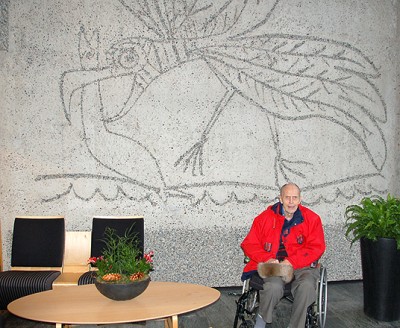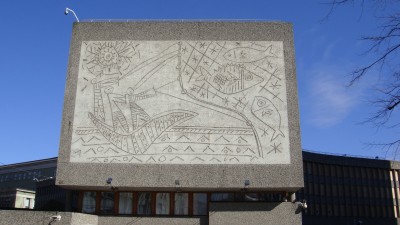Carl Nesjar sandblasted his way into the annals of art history in cooperation with Pablo Picasso, and then blasted through quite a few other artistic battles over the course of his long career. When Nesjar, one of Norway’s most internationally known artists, died at age 94 over the weekend, it seemed unlikely the battles over his art would die with him.

Nesjar’s legacy was being called as solid as the stone material he often worked with. Obituaries and tributes continued to emerge on Tuesday, three days after the artist died. He lived and had his studio in one of the artists’ residents at Bøler in Oslo, where newspaper Dagsavisen reported that he “worked until the end,” just shy of what would have been his 95th birthday in July.
He was perhaps best known for his decades-long cooperation with Picasso. It started with art for the new government offices being built in downtown Oslo in the 1950s, in which Nesjar sandblasted motifs based on sketches by Picasso into the walls of both the so-called Høyblokka, the high-rise that formed the centerpiece of the state government’s new office complex, and the Y-blokka, the low-rise building that was finished in 1969 and now faces destruction. Both buildings were badly damaged in the bombing by an ultra right-wing Norwegian on July 22, 2011.

The high-rise with Nesjar’s art is to remain intact, while the low-rise is to make way for entirely new buildings proposed for the redevelopment of the area known as Regjeringskvartalet. The walls containing Nesjar’s and Picasso’s art are to be preserved and displayed as part of the new complex, but a public debate is underway and Nesjar himself said he couldn’t understand the decision to tear down Y-blokka and displace such artworks as Fiskerne and Måken.
It’s not the first time Nesjar’s and Picasso’s art has stirred controversy. Their large Sylvette statues, one of which can be seen in the small lakeside town of Kristinehamn in Sweden, were not entirely well-received and kicked up a major fight in his birthplace of Larvik, on the coast southwest of Oslo. He nonetheless was later named an honorary citizen of Larvik along with receiving a string of distinctions including royal decorations.

Nesjar was born Carl Carlsen in Larvik in 1920 but later changed the family name to the Norse name for the coastal area near Larvik where the battle between Olav Haraldsson and Svein Jarl took place in 1016. He grew up in Larvik and Brooklyn, New York, where he later studied at the Pratt Institute during the years of President Franklin D Roosevelt’s New Deal. He spent the war years back in occupied Norway, where he studied at an illegal art academy, and then studied after the war in Copenhagen, New York and Paris.
Norwegian Broadcasting (NRK) reported over the weekend how Nesjar experimented with materials, and made breakthroughs in their use. In addition to his sandblasting on stone, Nesjar was a painter, graphic artist, photographer and sculptor, and his works can be found in the form of fountains, sculptures and public art from his native Scandinavia to Princeton, New Jersey and Spain. He was married for several years to another Norwegian artist, Inger Sitter, who also died earlier this year and was well-known for the abstract art that Nesjar, Jakob Wiedemann, Gunnar S Gundersen and, of course, Picasso, championed.
Now another fight over Nesjar’s and Picasso’s art looks set to continue. “Perhaps there was a meaning behind his choice of a family name after Norway’s first dated sea battle at Nesjar along the Vestfold coast,” wrote Mode Steinkjær, culture editor at Dagsavisen. Funeral arrangements were pending.
newsinenglish.no/Nina Berglund

